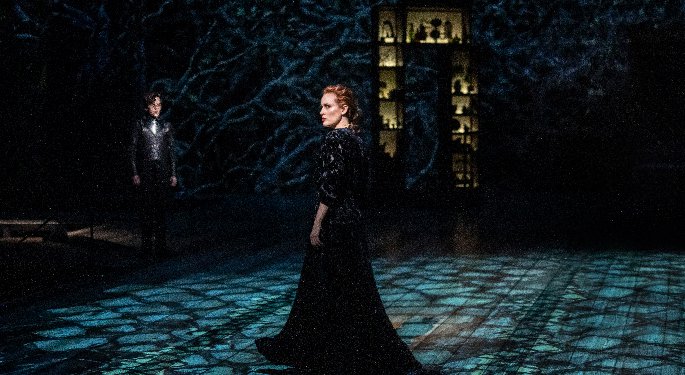The field of projection design is still recent enough that when I sat down with Ben Pearcy, who for the company 59 Productions did the evocative projections for both The Coast Starlight and Camelot, I felt compelled to ask simply: “Exactly what is it that projection designers do.” He responded in kind: “We make light.”
Pearcy elaborated: “Our discipline exists in a world between lighting design and scenic design, and we work closely with people in those areas. We read and analyze the script, we do lots of research, we have conversations with the director, we create our toolbox.” That toolbox can include creating 3D models, working in Photoshop, and the manipulation of pre-existing video footage.
The Coast Starlight, for example, uses licensed imagery of a train in motion. “The design of the production is abstract,” Pearcy said, “so we came up with a concept of using footage in a treated way. It has no realistic form – you don’t see the view outside the train window, but the projections have the rhythm and movement of train footage.”
Production design for The Coast Starlight was also influenced by the work of James Turrell, the American artist acclaimed for his work with light and space. Pearcy, who studied design at Boston University, spent a decade assisting Turrell. “He has a series of works,” Pearcy said, “that has a television at the bottom of an opening. All you see is an aperture opening with the light from the television. So you can’t see the TV screen; all you can see is the light from it, which flickers and changes colors.” Just as you can’t see the television in the Turrell, so in The Coast Starlight we can’t see actual trees or sky or ocean out the train window: only rhythm and movement.
For Camelot, the projections are more literal. Pearcy commented: “Michael Yeargan’s wonderful set design utilizes the vast reach of the Beaumont stage. There aren’t a ton of furnishings, so the projections help suggest places: the grand hall of a palace, the atmosphere of a knights’ tournament.” Speaking of lighting designer Lap Chi Chu, his collaborator for both Camelot and The Coast Starlight, Pearcy said: “For King Arthur’s world, Lap has done beautiful work that is well-balanced with what we’re doing with the projections.”
The Beaumont stage is so spacious that designing elaborately is tempting. “We had to be very careful about that,” Pearcy said. “With projections, you can do a very small thing and it can have a huge impact. I always say the projection is a very sharp knife so you have to cut very carefully.”
Pearcy’s awareness of the Beaumont’s challenges comes from experience. His and 59 Productions’ first assignment in the space was War Horse more than a decade ago, and Pearcy now runs the New York arm of the company. His inspiration to pursue a theatrical career came when, as a child, he saw a touring production of Les Miserables. “I was struck,” he said, “by the way David Hersey’s lighting helped tell the story. For example, when somebody had just died the light would get very bright on them.”
When I asked Pearcy to name his favorite professional credit he replied: “I’m always in love with the project I’m doing. I’m happiest when I’m tech-ing a show, partly because I have to think fast on my feet. We come into those rehearsals with pre-designed tools, but there are always things that arise requiring in-the-moment solutions. That can be challenging but also fun.” He added: “I always try to remember that those of us who do projection design are writing the textbook as we go along. People have been designing scenery for thousands of years and lighting for hundreds of years. With non-slide projection we’ve only been working for tens of years. It’s still a new discipline and that’s exciting.”
Brendan Lemon is a freelance journalist in New York.
